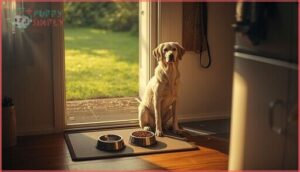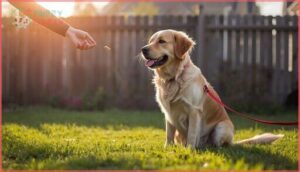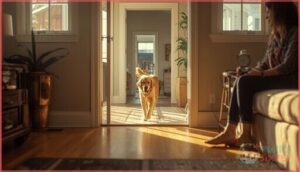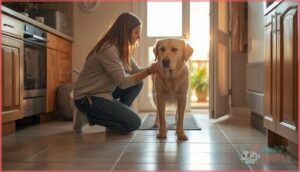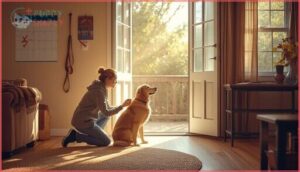This site is supported by our readers. We may earn a commission, at no cost to you, if you purchase through links.
Most people assume housebreaking is something you do with puppies, not adult dogs. But an older dog who never learned—or who’s regressed after a move, a health issue, or years of neglect—can absolutely master this skill. The timeline might look different than with a puppy, and the approach needs to account for their history, but the result is just as achievable.
What changes isn’t the dog’s ability to learn; it’s your strategy for teaching them. The good news is that housebreaking older dogs often comes down to three core elements: establishing predictable routines, recognizing what your dog is trying to tell you, and using reinforcement methods that actually work.
Once you understand how to combine these, you’ll transform what feels like an impossible situation into a manageable, learnable process.
Table Of Contents
- Key Takeaways
- Establishing a Housebreaking Routine
- Recognizing Housebreaking Signals
- Overcoming Common Housebreaking Challenges
- Effective Training Techniques for Older Dogs
- Tips for Lasting Success in Housebreaking
- Frequently Asked Questions (FAQs)
- How do you potty break an older dog?
- At what age is it too late to potty train a dog?
- Can a 7 year old dog be housebroken?
- How to break bad potty habits in dogs?
- How long does it take to housebreak an older dog?
- Can older dogs learn to use a litter box?
- What role does nutrition play in housebreaking success?
- How do I housebreak an older dog with mobility issues?
- Can I use puppy pads for housebreaking an older dog?
- How long does housebreaking typically take for older dogs?
- Conclusion
Key Takeaways
- Housebreaking older dogs succeeds through three core elements: establishing predictable feeding and potty schedules, recognizing your dog’s elimination signals like sniffing or pacing, and using immediate positive reinforcement when they eliminate outside.
- Medical issues such as urinary tract infections, incontinence, or hormonal imbalances often masquerade as training failures, so rule out health problems with your vet before assuming it’s purely behavioral.
- Territorial marking differs from standard housebreaking accidents—neutering resolves 60-90% of marking cases in intact males, while already-neutered dogs need strict environmental management and enzymatic cleaners to break the pattern.
- Most adult dogs become reliably housebroken within two to four months with consistent routines, but patience matters more than speed since punishment and frustration actually worsen accidents by increasing anxiety.
Establishing a Housebreaking Routine
Your older dog’s success starts with a solid routine, and that means being deliberate about when and where he eats and goes outside. Dogs thrive on predictability, so you’ll want to establish consistent feeding times, regular potty breaks, and structured periods for rest and play.
Let’s walk through the specific strategies that work best for building this foundation.
Setting Consistent Feeding and Potty Times
The foundation of successful housebreaking rests on predictability. When you establish a consistent schedule with fixed feeding times and coordinated potty breaks, your older dog’s elimination patterns become reliably timed—making your job infinitely easier. A consistent feeding schedule also helps with regular dog feeding, which aids in digestion and predictable elimination.
Here’s what routine coordination looks like:
- Feed at the same times daily (usually morning and evening), removing uneaten food after 30 minutes
- Take your dog outside within 10–30 minutes after each meal to capitalize on the meal-potty link
- Schedule additional potty opportunities every two hours, plus trips after play and before bedtime
This predictability transforms housebreaking from guesswork into a learnable pattern.
Using Leashed Walks to Reinforce Training
While a consistent feeding schedule gets things rolling, leashed walks are where the real training happens. Take your dog outside on leash three to five times daily, particularly after meals and naps. Don’t rush—give them several minutes to relax and eliminate.
When they do their business outside, reward immediately with treats or praise while still on leash. This immediate positive reinforcement strengthens the connection between outdoor elimination and good things, making housebreaking stick faster than you’d expect. Positive reinforcement with treats can encourage effective leash training.
Crate Training for Supervision and Security
Once your leashed walks establish the pattern, a properly sized crate becomes your supervision tool between outdoor trips. Think of it as a den where your dog naturally won’t soil their sleeping space. Dogs confined just large enough to stand, turn, and lie down show dramatically reduced accidents while you’re away. This strategy pairs perfectly with your schedule, preventing rehearsal of indoor habits while building security through calm, voluntary time inside.
- Size the crate appropriately—oversized crates encourage soiling
- Keep it clean and comfortable to condition positive associations
- Combine crate time with frequent outdoor potty breaks for success
Gradually Increasing Freedom Indoors
Now comes the patient work of expanding your dog’s world. Start with 15–30 minutes in a single dog-proofed room while you watch closely—think of it as supervised freedom, not free rein. After several consecutive accident-free days, extend to 1–2 hours.
By weeks 5–6, you can add another room or two, always with your eyes on your dog. This gradual freedom progression prevents rehearsal of bad habits while building trust.
Older dogs especially need slower adaptation timeframes, so flexibility matters more than speed.
Recognizing Housebreaking Signals
Your older dog mightn’t always tell you straight out when nature calls, but there are signs you can learn to spot before accidents happen.
Understanding what your dog is actually trying to communicate—whether it’s pacing, sniffing, whining, or heading toward the door—makes all the difference in catching those moments in time.
Let’s walk through the signals to watch for and how you can step in early to prevent mishaps.
Identifying Signs of Needing to Eliminate
Your older dog broadcasts elimination needs through predictable signals—if you know what to watch for, you’ll catch them before accidents happen. Dogs communicate through body language and behavior patterns that emerge minutes before they need to go.
Here’s what to recognize:
- Body postures: Sudden squatting, leg lifting, or ground scratching before elimination
- Sniffing patterns: Focused, repetitive sniffing of specific floor areas or spots
- Movement changes: Slow pacing, circling in place, or wandering away from you
- Vocal cues: Barking, whining, or scratching at doors
- Routine changes: Restlessness, nighttime pacing, or increased urgency to access outdoors
These signals give you a window to redirect your dog outside successfully.
Preventing Accidents Through Early Intervention
Once you spot those elimination signals, act fast—every second counts. Getting your dog outside immediately prevents accidents from becoming habits. Early veterinary visits rule out medical issues like incontinence or urinary tract infections that complicate training.
Watch for behavioral red flags such as fear or anxiety, which may require specialized approaches. Structured schedules combined with supervised environments keep mistakes minimal.
For accidents that happen, enzymatic cleaners remove odors completely, preventing repeat soiling in the same spots. Consistency builds confidence in older dogs.
Overcoming Common Housebreaking Challenges
Housebreaking an older dog isn’t always straightforward, and the obstacles you face will often depend on your dog’s background and current situation.
The good news is that most challenges have practical solutions once you understand what’s actually causing the accidents.
Let’s walk through the most common issues you’ll encounter and how to address them.
Addressing Previous Lack of Training
Many owners underestimate what “housebroken” really means. If your dog had only rough outdoor access before, that 20% accident rate wasn’t training failure—it was inconsistent routines creating habits.
Remedial housetraining for older dogs requires returning to a puppy-style schedule: outdoor trips every 2–4 hours initially. This breaking of entrenched indoor elimination patterns takes weeks, not days.
Your consistency matters more than your dog’s age. Early training impact is real, but adult dogs absolutely can learn when given structured management and clear expectations.
Managing Medical Issues and Incontinence
Before you blame your dog’s accidents on stubbornness, a veterinarian needs to rule out medical causes. Urinary tract infections, sphincter incompetence (especially common in spayed females), and hormonal issues account for many “housebreaking failures.”
A diagnostic workup including urinalysis and bloodwork identifies underlying problems. UTI screening alone reveals infections in up to 39% of chronically house-soiling dogs.
Hormone therapy and environmental support—like washable pads and frequent potty breaks—often resolve accidents that training alone can’t fix.
Handling Environmental Changes and Stress
When your dog’s world shifts—a move, schedule changes, or new household members—housebreaking often regresses. Disrupted routines trigger stress responses that override training.
Your older dog needs three things: predictable feeding and potty schedules, a consistent environment, and stress management. Create a designated potty area, maintain fixed outdoor times, and consider pheromone diffusers or white-noise masking to ease anxiety during transitions.
Environmental stability rebuilds confidence faster than retraining alone.
Solutions for Territorial Marking and Stubbornness
Territorial marking differs from standard housebreaking—your dog isn’t forgetting training; he’s claiming territory. Neutering impact is significant: roughly 60 to 90 percent of intact males stop marking after surgery.
For already-neutered dogs, strict management works best. Block access to previously marked spots, increase supervised outdoor time, and use enzymatic cleaners for thorough odor removal.
Environmental solutions like baby gates combined with behavior modification address marking prevention effectively. Persistent cases warrant a veterinary behaviorist’s expertise.
Effective Training Techniques for Older Dogs
Now that you understand the challenges older dogs face, let’s talk about what actually works to fix them. The right training techniques can make all the difference, and the good news is that older dogs are often keen to learn when you use methods built around how they naturally think.
Here are the most effective approaches that will set you and your dog up for real success.
Positive Reinforcement Methods
Positive reinforcement transforms housebreaking by rewiring your older dog’s brain around reward, not punishment. Food treats, play, and praise create dopaminergic pathways that strengthen learning and memory retention far better than aversive methods. Dogs trained with rewards show fewer stress behaviors and higher engagement.
Positive reinforcement rewires older dogs’ brains around reward, not punishment, creating stronger learning pathways than any aversive method
Treat variety keeps motivation high—rotate between kibble, small treats, and play to maintain novelty. This shaping behavior approach works across all ages, making it ideal for dogs with limited prior training histories.
Immediate Feedback and Timely Rewards
Timing separates success from frustration. Your dog connects the reward to the behavior only when it arrives within one to two seconds of elimination—any longer, and the association dissolves.
Here’s what works:
- Reward at the elimination site, not indoors
- Deliver treats or praise immediately after your dog finishes
- Use a marker word (“Yes!”) to signal the exact moment of success
Consistent reinforcement over weeks builds reliability far better than sporadic rewards. Your older dog’s brain learns fastest with this precision.
Using Enzymatic Cleaners to Remove Odors
While rewards cement learning, eliminating odor sources prevents backsliding. When accidents happen—and they will—enzymatic cleaners do what regular detergents can’t. These products contain proteases and lipases that break down uric acid crystals, the persistent compounds that trigger repeat soiling. Saturate the entire soiled area, including carpet backing, and let it sit overnight. This complete odor removal discourages your dog from marking the same spot again, turning cleanup into a training tool itself.
| Enzyme Type | What It Breaks Down | Why It Matters |
|---|---|---|
| Protease | Protein residues | Targets urine’s primary component |
| Amylase | Carbohydrates | Removes starch-based waste |
| Lipase | Fat residues | Eliminates oily odor compounds |
| Uric acid crystals | Persistent odor source | Prevents re-soiling triggers |
| Bio-bacteria | Ongoing residue | Extends odor reduction for hours |
Incorporating Technology and Customized Plans
Once you’ve tackled odor removal, technology can accelerate your progress. Wearable trackers monitor your dog’s activity patterns and elimination frequency, helping you fine-tune feeding and potty schedules.
App-based training platforms offer structured lessons adapted to older dogs, while remote coaching connects you with trainers for real-time feedback. AI personalization adapts plans based on your dog’s specific responses.
Data-driven insights transform guesswork into precision—you’ll know exactly when your dog needs to go outside, dramatically improving housebreaking success.
Tips for Lasting Success in Housebreaking
You’ve made real progress with training, but the hard part isn’t over—staying consistent is what actually locks in those good habits. Success comes down to patience with setbacks, avoiding mistakes that can undo your work, and knowing when it’s time to bring in a vet or trainer.
Let’s walk through what keeps owners on track and what to watch out for.
Maintaining Patience and Consistency
House-training an older dog is a marathon, not a sprint. Most dogs need several weeks of strict routines before reliably signaling elimination outside.
Your calm reactions matter enormously—frustration and punishment actually worsen accidents by increasing anxiety. Instead, greet your dog calmly, redirect outdoors immediately, and clean messes out of sight.
Consistent reinforcement every single day, paired with patience through plateaus and setbacks, is what transforms house-soiling into reliable habits. This long-term commitment pays off.
Avoiding Common Housebreaking Mistakes
Most owners accidentally sabotage progress by punishing accidents, which spikes anxiety and worsens soiling. Skip the scolding—instead, clean thoroughly with enzymatic cleaners to remove odor cues that dogs follow back to problem spots.
Inconsistent schedules derail everything, so lock in feeding and potty times. Oversized crates backfire too; dogs eliminate in them when given too much space.
Medical issues like incontinence mimic training failure, so rule those out first with your vet.
When to Seek Professional or Veterinary Help
When do accidents signal something beyond training? If sudden accidents appear in a previously reliable dog, medical issues like urinary tract infections or incontinence often hide beneath behavioral problems.
Diagnostic thresholds matter: after two to four weeks of consistent routine, ongoing accidents warrant veterinary evaluation. Watch for medical signs—increased drinking, straining, or hematuria—or behavioral changes like anxiety.
Training failure despite strict management usually means professional help from a veterinarian or certified behaviorist is needed.
Frequently Asked Questions (FAQs)
How do you potty break an older dog?
Potty training an older dog starts with establishing a consistent routine. Take them out first thing in the morning, after meals, and before bed.
Use a leash, reward success immediately, and confine them when unsupervised to prevent accidents indoors.
At what age is it too late to potty train a dog?
There’s no magic age cutoff—dogs can learn toileting habits well into their senior years.
What matters is veterinary evaluation to rule out medical issues like incontinence or cognitive decline, then consistent training adapted to their individual needs and capacity.
Can a 7 year old dog be housebroken?
Yes, a 7-year-old dog can absolutely be housebroken. Adult dogs hold urine longer than puppies, making structured training manageable.
Success depends on consistency, health screening, and appropriate routines—not age itself. Many older dogs respond reliably to consistent schedules and positive reinforcement within weeks.
How to break bad potty habits in dogs?
Breaking bad potty habits requires identifying root causes—medical issues, stress, or incomplete training—then combining consistent reinforcement with environmental management.
Use enzymatic cleaners, establish predictable routines, and reward outdoor elimination heavily to replace old patterns with new ones.
How long does it take to housebreak an older dog?
Most adult dogs become reliably housebroken within two to four months with consistent training. Prior training history, medical factors, and training intensity greatly impact the timeline.
Previously house-trained dogs adapt faster, while those with health issues may need longer adjustment periods.
Can older dogs learn to use a litter box?
Many older dogs can successfully learn to use a litter box, especially small breeds or those with mobility issues. Training timeframes span several weeks using positive reinforcement. Regular cleaning maintains hygiene and prevents aversion.
What role does nutrition play in housebreaking success?
Food forms the foundation for predictable potty patterns. Diet consistency and feeding schedules regulate digestive health, minimizing medical issues in dogs.
Senior dog training responsiveness improves when nutrition bolsters stable elimination timing and overall pet health.
How do I housebreak an older dog with mobility issues?
Senior dogs with joint pain or arthritis need ramps, level-access potty spots, and indoor grass pads to reduce stair climbing.
Schedule bathroom breaks every 2–4 hours and consult your vet about pain management.
Can I use puppy pads for housebreaking an older dog?
Yes, you can use puppy pads for housebreaking older dogs, especially when medical considerations like incontinence or mobility issues make outdoor trips difficult. However, pads work best alongside consistent training methods and outdoor adaptation plans.
How long does housebreaking typically take for older dogs?
Training duration for older dogs usually spans a few weeks to several months. Breed influence, prior history, medical factors, and routine consistency all shape your timeline—some dogs succeed in under two weeks with a solid training plan.
Conclusion
What’s the real secret behind housebreaking older dogs? It’s not magic—it’s your willingness to adapt, observe, and respond. When you set clear routines, recognize your dog’s signals, and reinforce good habits, progress follows.
Every accident is simply feedback, not failure. With each step, you’re building trust and understanding. Remember, your dog’s age is just a number; their ability to learn is timeless.
The journey ends with a cleaner home—and a stronger bond.
- https://www.sciencedirect.com/science/article/pii/S0168159124000121
- https://news.okstate.edu/articles/communications/2019/treating-canine-urinary-incontinence.html
- https://www.barkleyandpaws.com/dogs-pets/training/the-definitive-guide-to-house-training-an-older-dog/
- https://www.americanhumane.org/public-education/housetraining-puppies-dogs/
- https://ruralveterinaryoutreach.org/2022/02/08/how-to-achieve-bomb-proof-housebreaking/


